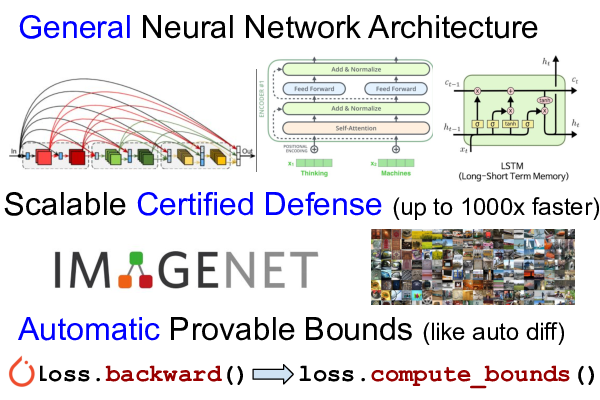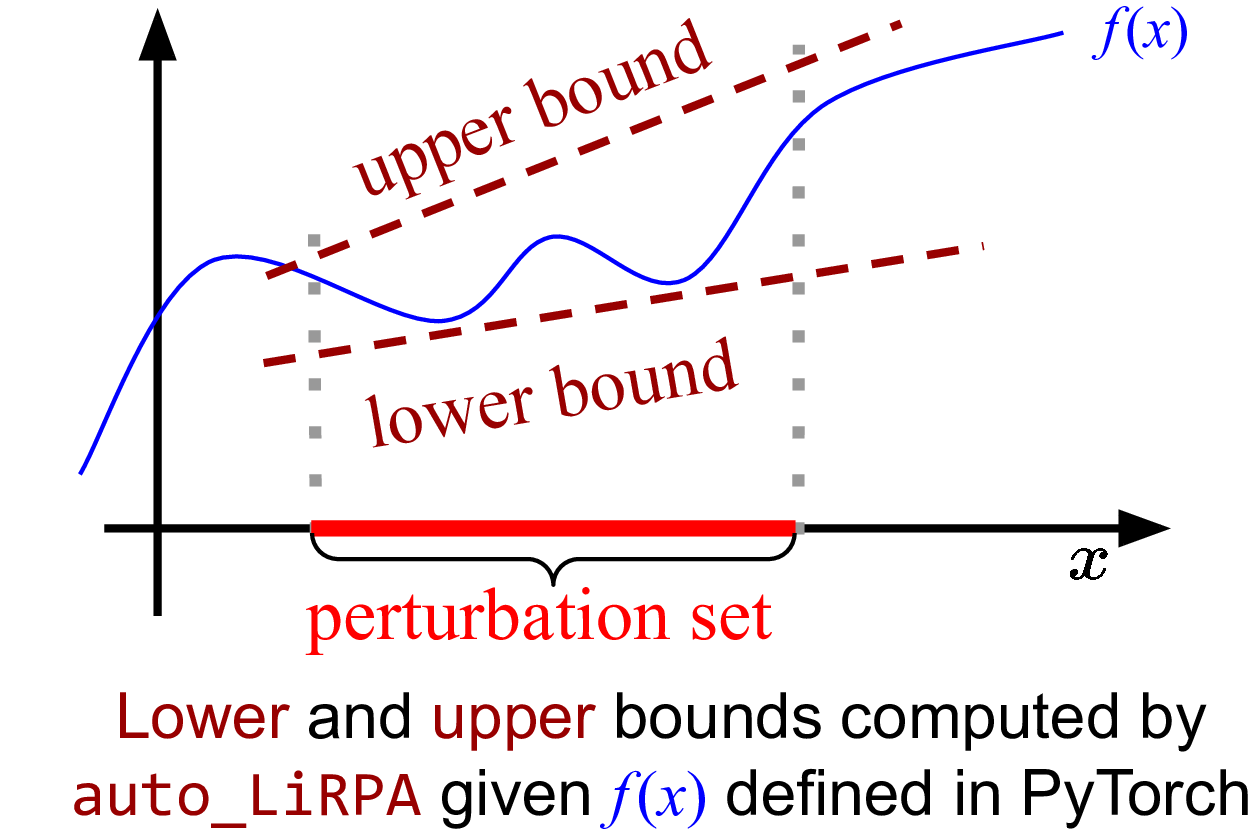- A memory efficient GPU implementation of backward (CROWN) bounds for convolutional layers. See examples/vision/patch_convolution.py for a comparison. (10/31/2020)
- We released our certified defense models for downscaled ImageNet, TinyImageNet, CIFAR-10, and LSTM/Transformers. (08/20/2020)
- Adding support to complex vision models including DenseNet, ResNeXt and WideResNet. (06/30/2020)
- Loss fusion, a technique that reduces training cost of tight LiRPA bounds (e.g. CROWN-IBP) to the same asympototic complexity of IBP, making LiRPA based certified defense scalable to large datasets (e.g., TinyImageNet, downscaled ImageNet). (06/30/2020)
- Multi-GPU support to scale LiRPA based training to large models and datasets. (06/30/2020)
- Initial release. (02/28/2020)
What is auto_LiRPA? auto_LiRPA is a library for automatically deriving
and computing bounds with linear relaxation based perturbation analysis (LiRPA)
(e.g. CROWN and
DeepPoly) for
neural networks. LiRPA algorithms can provide guaranteed upper and lower
bounds for a neural network function with perturbed inputs. These bounds are
represented as linear functions with respect to the variable under
perturbation. LiRPA has become an important tool in robustness verification and
certified adversarial defense, and can become an useful tool for many other
tasks as well.
Our algorithm generalizes existing LiRPA algorithms for feed-forward neural networks to a graph algorithm on general computational graphs. We can compute LiRPA bounds on a computational graph defined by PyTorch, without manual derivation. Our implementation is also automatically differentiable, allowing optimizing network parameters to shape the bounds into certain specifications (e.g., certified defense).
Supported Features: We support backward/forward mode perturbation analysis and interval bound propagation (IBP, which can be seen as a degenerate case of LiRPA) on general computational graphs, as well as hybrid approaches such as IBP+Backward (CROWN-IBP), Forward+Backward.
Why we need auto_LiRPA? We aim to facilitate the application of efficient
linear relaxation based perturbation analysis (LiRPA). Existing works have
extended LiRPA from feed-forward networks to a few more network structures like
ResNet, RNN and Transformer, however they require manual derivation and
implementation of the bounds for each new type of network. We allow automatic
bound derivation and computation for general computational graphs, in a similar
manner that gradients are obtained in modern deep learning frameworks -- users
only define the computation in a forward pass, and auto_LiRPA traverses through
the computational graph and derives bounds for any nodes on the graph. With
auto_LiRPA we free users from deriving and implementing LiPRA for most common
tasks, and they can simply apply LiPRA as a tool for their own applications.
This is especially useful for users who are not experts of LiRPA and cannot
derive these bounds manually (LiRPA is significantly more complicated than
backpropagation).
We provide a wide range of examples of using auto_LiRPA. See More
Examples below. The main algorithm of auto_LiRPA is
discussed in our NeurIPS 2020 paper. Please refer to
the the guide for reproducing paper results.
Automatic Perturbation Analysis for Scalable Certified Robustness and Beyond. Kaidi Xu*, Zhouxing Shi*, Huan Zhang*, Yihan Wang, Kai-Wei Chang, Minlie Huang, Bhavya Kailkhura, Xue Lin, Cho-Jui Hsieh (* equal contribution). NeurIPS 2020.
Please cite our paper if you use the auto_LiRPA library. If you encounter
any problems with this library, feel free create an issue or pull request. We
welcome contributions in any form from anyone.
Python 3.7+ is required. Pytorch 1.4, 1.5 and 1.6 are supported.
Before you run any examples, please install auto_LiRPA first:
git clone https://github.com/KaidiXu/auto_LiRPA
cd auto_LiRPA
python setup.py install
If you intend to modify this library, use python setup.py develop instead).
This library is still under heavy development. We are still working
on implementing more primitive operations on computational graphs. These
operations are implemented in auto_LiRPA/bound_ops.py. For example, if you
add a custom activation function that is not supported by our framework, you
can implement it in this file.
First define your computation as a nn.Module and wrap it using
auto_LiRPA.BoundedModule(). Then, you can call the compute_bounds function
to obtain certified lower and upper bounds under perturbation:
from auto_LiRPA import BoundedModule, BoundedTensor, PerturbationLpNorm
# Define computation as a nn.Module
class MyModel(nn.Module):
def forward(self, x):
# Define your computation here
model = MyModel()
my_input = load_a_batch_of_data()
# Wrap the model with auto_LiRPA
model = BoundedModule(model, my_input)
# Define perturbation
ptb = PerturbationLpNorm(norm=np.inf, eps=0.1)
# Make the input a BoundedTensor with perturbation
my_input = BoundedTensor(my_input, ptb)
# Regular forward propagation using BoundedTensor works as usual.
prediction = model(my_input)
# Compute LiRPA bounds
lb, ub = model.compute_bounds(x=(my_input,), method="backward")Checkout examples/vision/simple_verification.py for a complete but very basic example.
We provide many examples of using our auto_LiRPA library,
including robustness verification and certified robust training for fairly
complicated networks and specifications. Please first install required libraries
to run the examples:
cd examples
pip install -r requirements.txtWe provide a very simple tutorial for auto_LiRPA at
examples/vision/simple_verification.py.
This script is self-contained. It loads a simple CNN model and compute the
guaranteed lower and upper bounds using LiRPA for each output neuron under a L
infinity perturbation.
cd examples/vision
python simple_verification.pyWe provide a simple example of certified training. By default it uses CROWN-IBP to train a certifiably robust model:
cd examples/vision
python simple_training.pyThe default model is a small ResNet model for MNIST, used in Scaling provable adversarial defenses . You should get less than 10% verified error (at Linf eps=0.3) after training.
We also provide an L0-norm option in simple_training.py and an example to use
L0-norm certified training to train an MLP model. The IBP bounds for L0-norm
is provided in Chiang et
al., but here we
also use the tighter backward mode perturbation analysis for L0-norm which is
the first time in literature.
cd examples/vision
python simple_training.py --model mlp_3layer --norm 0 --eps 1For CIFAR-10, we provided some sample models in examples/vision/models:
e.g., cnn_7layer_bn,
DenseNet,
ResNet18,
ResNeXt. For example, to train a ResNeXt model on CIFAR,
use:
python cifar_training.py --batch_size 256 --model ResNeXt_cifarSee a list of supported models here. This command uses multi-GPUs by default. You probably need to reduce batch size if you have only 1 GPU. The CIFAR training implementation includes loss fusion, a technique that can greatly reduce training time and memory usage of LiRPA based certified defense.
Pretrained models for CIFAR-10: We released our CIFAR-10 certified defense models here. To compute verified error, please run:
python cifar_training.py --verify --model cnn_7layer_bn --load saved_models/cnn_7layer_bn_cifar --eps 0.03137254901961More example of CIFAR-10 training can be found in doc/paper.md.
Loss fusion is essential for certified training on Tiny-ImageNet (200 classes) or downscaled ImageNet (1000 classes) using LiRPA based bounds (e.g., CROWN-IBP). This technique leads to ~50X speeding up on training time and also greatly reduces memory usage.
First, we need to prepare the data, for Tiny-ImageNet:
cd examples/vision/data/tinyImageNet
bash tinyimagenet_download.shTo train the WideResNet model on Tiny-Imagenet:
cd examples/vision
python tinyimagenet_training.py --batch_size 100 --model wide_resnet_imagenet64For downscaled ImageNet, please download raw images (Train and Val, 64x64, npz format) from
Image-Net.org to example/vision/data/ImageNet64/raw_data,
decompress them and then run data preprocessing:
cd examples/vision/data/ImageNet64
python imagenet_data_loader.pyTo train the WideResNet model on downscaled Imagenet:
cd examples/vision
python imagenet_training.py --batch_size 100 --model wide_resnet_imagenet64_1000classPretrained models for ImageNet: We released our certified defense models (trained with loss fusion) for Tiny-Imagenet and downscaled Imagenet. To evaluate the clean error and verified error:
# This is the model saved path.
MODEL=saved_models/wide_resnet_imagenet64_1000
# Run evaluation.
python imagenet_training.py --verify --model wide_resnet_imagenet64_1000class --load $MODEL --eps 0.003921568627451See more details in doc/paper.md for these examples.
In examples/sequence, we have an example of training a certifiably robust LSTM on MNIST, where an input image is perturbed within an Lp-ball and sliced to several pieces each regarded as an input frame. To run the example:
cd examples/sequence
python train.pyIn examples/language, we show that our framework can support perturbation specification of word substitution, beyond Lp-ball perturbation. We perform certified training for Transformer and LSTM on a sentiment classification task.
First, download data and extract them to examples/language/data:
cd examples/language
wget http://download.huan-zhang.com/datasets/language/data_language.tar.gz
tar xvf data_language.tar.gzWe use $DIR to represent the directory for storing checkpoints. Then, to train a robust Transformer:
python train.py --dir=$DIR --robust --method=IBP+backward_train --train
python train.py --load=$DIR/ckpt_25 --robust --method=IBP+backward # for verificationAnd to train a robust LSTM:
python train.py --dir=$DIR --model=lstm --lr=1e-3 --robust --method=IBP+backward_train --dropout=0.5 --train
python train.py --model=lstm --load=$DIR/ckpt_25 --robust --method=IBP+backward # for verificationPretrained models for Transformer/LSTM: We provide our certified defense models for Transformer and LSTM. To directly evaluate them:
# Download and evaluate our trained Transformer
wget http://web.cs.ucla.edu/~zshi/files/auto_LiRPA/trained/ckpt_transformer
python train.py --load=ckpt_transformer --robust --method=IBP+backward
# Download and evaluate our trained LSTM
wget http://web.cs.ucla.edu/~zshi/files/auto_LiRPA/trained/ckpt_lstm
python train.py --model=lstm --load=ckpt_lstm --robust --method=IBP+backwardWe provide an example for training a robust network under weight perturbations by applying LiRPA bounds on network weights rather than data inputs (our algorithm considers general computational graphs, and model weights are also inputs of a computational graph, so LiRPA bounds can be naturally applied on weights). This essentially obtains a network that has "flat" optimization landscape (a small change in weight parameters do not change loss too much).
cd examples/vision
python weights_training.py --norm 2 --bound_type CROWN-IBPIf you have an example based on auto_LiRPA that can be potentially helpful
for other users, you are encouraged to create a pull request so that we can
include your example here. Any contributions from the community will be
greatly appreciated.

